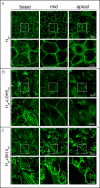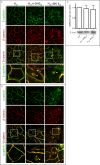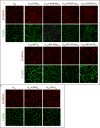Sphingosine kinase and sphingosine-1-phosphate regulate epithelial cell architecture by the modulation of de novo sphingolipid synthesis
- PMID: 30897151
- PMCID: PMC6428330
- DOI: 10.1371/journal.pone.0213917
Sphingosine kinase and sphingosine-1-phosphate regulate epithelial cell architecture by the modulation of de novo sphingolipid synthesis
Abstract
Sphingolipids regulate several aspects of cell behavior and it has been demonstrated that cells adjust their sphingolipid metabolism in response to metabolic needs. Particularly, sphingosine-1-phosphate (S1P), a final product of sphingolipid metabolism, is a potent bioactive lipid involved in the regulation of various cellular processes, including cell proliferation, cell migration, actin cytoskeletal reorganization and cell adhesion. In previous work in rat renal papillae, we showed that sphingosine kinase (SK) expression and S1P levels are developmentally regulated and control de novo sphingolipid synthesis. The aim of the present study was to evaluate the participation of SK/S1P pathway in the triggering of cell differentiation by external hypertonicity. We found that hypertonicity evoked a sharp decrease in SK expression, thus activating the de novo sphingolipid synthesis pathway. Furthermore, the inhibition of SK activity evoked a relaxation of cell-cell adherens junction (AJ) with accumulation of the AJ complex (E-cadherin/β-catenin/α-catenin) in the Golgi complex, preventing the acquisition of the differentiated cell phenotype. This phenotype alteration was a consequence of a sphingolipid misbalance with an increase in ceramide levels. Moreover, we found that SNAI1 and SNAI2 were located in the cell nucleus with impairment of cell differentiation induced by SK inhibition, a fact that is considered a biochemical marker of epithelial to mesenchymal transition. So, we suggest that the expression and activity of SK1, but not SK2, act as a control system, allowing epithelial cells to synchronize the various branches of sphingolipid metabolism for an adequate cell differentiation program.
Conflict of interest statement
The authors have declared that no competing interests exist.
Figures








Similar articles
-
De novo biosynthesis of dihydrosphingosine-1-phosphate by sphingosine kinase 1 in mammalian cells.Cell Signal. 2006 Oct;18(10):1779-92. doi: 10.1016/j.cellsig.2006.01.018. Epub 2006 Mar 10. Cell Signal. 2006. PMID: 16529909
-
Differential branching of the sphingolipid metabolic pathways with the stage of development. Involvement of sphingosine kinase.Biol Neonate. 2003;84(3):243-51. doi: 10.1159/000072308. Biol Neonate. 2003. PMID: 14504448
-
Sphingosine kinase/sphingosine 1-phosphate signaling in cancer therapeutics and drug resistance.Handb Exp Pharmacol. 2013;(216):3-27. doi: 10.1007/978-3-7091-1511-4_1. Handb Exp Pharmacol. 2013. PMID: 23563649 Review.
-
Role of sphingosine kinase/S1P axis in ECM remodeling of cardiac cells elicited by relaxin.Mol Endocrinol. 2015 Jan;29(1):53-67. doi: 10.1210/me.2014-1201. Mol Endocrinol. 2015. PMID: 25415609 Free PMC article.
-
Sphingosine kinase 1 in cancer.Adv Cancer Res. 2013;117:201-35. doi: 10.1016/B978-0-12-394274-6.00007-8. Adv Cancer Res. 2013. PMID: 23290781 Free PMC article. Review.
Cited by
-
The functional antagonist of sphingosine-1-phosphate, FTY720, impairs gut barrier function.Front Pharmacol. 2024 Aug 19;15:1407228. doi: 10.3389/fphar.2024.1407228. eCollection 2024. Front Pharmacol. 2024. PMID: 39224783 Free PMC article.
-
Metabolic comparison of minimally to noninvasive urogenital sample types for studying gynecologic health: A pilot study.iScience. 2025 Jun 18;28(7):112938. doi: 10.1016/j.isci.2025.112938. eCollection 2025 Jul 18. iScience. 2025. PMID: 40678526 Free PMC article.
-
Bioavailable wine pomace attenuates oxalate-induced type II epithelial mesenchymal transition and preserve the differentiated phenotype of renal MDCK cells.Heliyon. 2020 Nov 18;6(11):e05396. doi: 10.1016/j.heliyon.2020.e05396. eCollection 2020 Nov. Heliyon. 2020. PMID: 33294652 Free PMC article.
-
A Rheostat of Ceramide and Sphingosine-1-Phosphate as a Determinant of Oxidative Stress-Mediated Kidney Injury.Int J Mol Sci. 2022 Apr 4;23(7):4010. doi: 10.3390/ijms23074010. Int J Mol Sci. 2022. PMID: 35409370 Free PMC article. Review.
References
-
- van Echten G, Birk R, Brenner-Weiss G, Schmidt RR, Sandhoff K. Modulation of sphingolipid biosynthesis in primary cultured neurons by long chain bases. J Biol Chem. United States; 1990;265: 9333–9339. - PubMed
-
- Hanada K. Serine palmitoyltransferase, a key enzyme of sphingolipid metabolism. Biochim Biophys Acta. Netherlands; 2003;1632: 16–30. - PubMed
Publication types
MeSH terms
Substances
LinkOut - more resources
Full Text Sources
Research Materials

